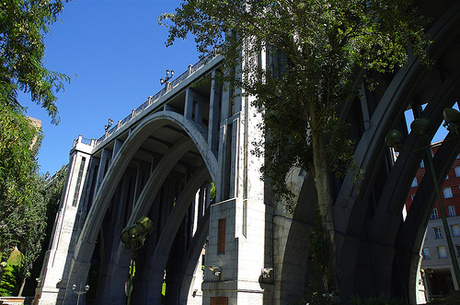Madrid's Viaduct
The "Viaducto de Segovia" is an easily recognizable landmark in Madrid, rising to a maximum height of 23 meters above the ground. The viaduct as it stands is relatively modern. Work was completed on the structure, which spans Calle de Segovia in the west of the city, in 1934. However, it has a much older and more interesting history.
A plan was conceived in the mid 18th century by an architect of the Royal Palace to build a structure similar to what exists today, but it did not materialize because of the lack of funds. In the early 19th century, Silvestre Perez, a royal architect tried to resurrect the plans, but was unable to.
Finally, in 1874 the plans were completed by Eugenio Barrón. That structure was made of wood and iron, and the church of Santa Maria de la Almudena, the oldest church in Madrid at the time, was demolished to make way for the construction.
Eugenio Barrón's structure stood until 1932. And then finally, the architects Ferrero, Aracil and Aldaz created new plans for a concrete structure, which was completed two years later. It suffered damage during the Spanish Civil War, but was made good again in 1942.
In the late 1970s it was very nearly decided to demolish the structure, However, a final decision was made to keep it intact. It was given a face lift at the time and restored to its former glory. The appearance of the structure today is a result of the 1970s restoration.
Unfortunately, the Viaducto de Segovia has gained a certain notoriety over the years as being a place for suicide attempts, mainly with young people. In 1998 the authorities were forced to erect transparent screens, limiting easy access to the edges, to prevent further suicide attempts.
Álvaro Burgos Goizueta aged 21 years tragically fell to his death from off the top of the viaduct on October 15, 2001 while filming a scene involving suicide for the film, Heatwave. Four people were charged for the incident when certain irregularities in the safety procedures were discovered.
The Palacio Real, on Calle Bailén, is a short distance north of the Viaducto de Segovia. Not far to the south of the viaduct stands Iglesia de San Francisco el Grande, an imposing 18th century church. It is believed that Saint Francis of Assisi founded the original church here in 1217.
The Viaducto de Segovia is a pleasing and modern-looking structure that still retains a certain classical architectural appearance.
This is a particularly interesting part of the city and several of the capital's best known landmarks are within walking distance, such as the Royal Palace, the old arab city walls, the Sabatini and Campo del Moro gardens, the Plaza de la Villa square with the historic Lujanes Tower, Casa de la Villa & Casa de Cisneros, and the magnificent Plaza Mayor square. You can get there via flight to Madrid.




